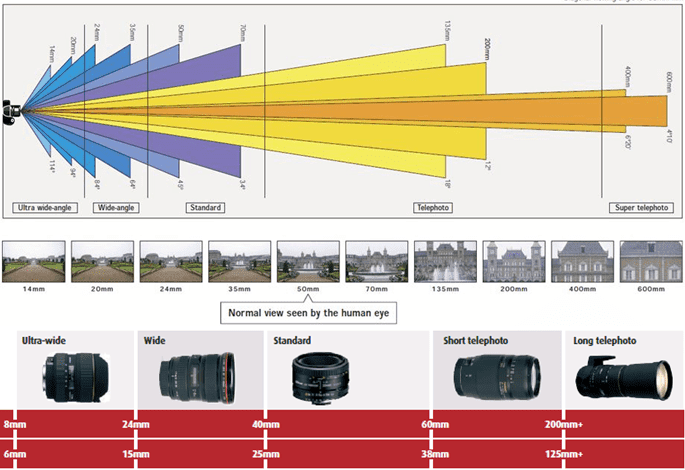What is Focal Length In photography?
Focal length is technically defined as the distance from the part of the optical path where the light converges to one point and passing through the lens which is focused onto the image plane or the digital image sensor.
This distance is usually measured in millimeters. From a practical point of view, focal length can be thought of as the amount of magnification of the lens. The longer the focal length, the more the lens magnifies the scene. In addition to magnification, the focal length determines the perspective and compression of the scene.
The focal length tells us the angle of view on how much of the scene will be captured and how large the magnification of each element will be.
The focal length of the lens just affects the magnification of your image, so if you stand in the same place you’ll get the same perspective from any lens. Try to take a picture on the widest setting of your zoom and another at the longest from the same spot. It will be exactly the same, just cropped.
The longer the focal length, the narrower the angle of view and the higher the magnification. The shorter the focal length, the wider the angle of view and the lower the magnification.
Focal length will affect your angle-of-view, and it's determined by the type of lenses. Every lens has a different focal length and it's expressed in millimeters.
For example, a 50mm lens gives roughly the same magnification as the human eye, so it’s called a standard lens.
Any lens with a focal length smaller than 50mm makes objects appear smaller and gives a wider angle-of-view. A focal length longer than 50mm magnifies objects and gives a narrower view.
A focal length of every lens is different, but in a small scope, it would be broken up into three categories. Telephoto, Standard, and Wide.
It should also be mentioned that on a wide-angle lens your angle of acceptance is much greater than on a standard or telephoto lens where your angle of acceptance is much less. This means that with a wide-angle lens, you can sometimes surprise yourself with how much you’ve included in your picture.
On the other hand, using a telephoto lens, your subject is more prominent and less of the background is included within your frame. So, by varying your lenses, and therefore your perspective, you can use the background to complement your pictures or isolate your subject as you require.
This distance is usually measured in millimeters. From a practical point of view, focal length can be thought of as the amount of magnification of the lens. The longer the focal length, the more the lens magnifies the scene. In addition to magnification, the focal length determines the perspective and compression of the scene.
The focal length tells us the angle of view on how much of the scene will be captured and how large the magnification of each element will be.
The focal length of the lens just affects the magnification of your image, so if you stand in the same place you’ll get the same perspective from any lens. Try to take a picture on the widest setting of your zoom and another at the longest from the same spot. It will be exactly the same, just cropped.
The longer the focal length, the narrower the angle of view and the higher the magnification. The shorter the focal length, the wider the angle of view and the lower the magnification.
Focal length and lens types
Focal length will affect your angle-of-view, and it's determined by the type of lenses. Every lens has a different focal length and it's expressed in millimeters.
For example, a 50mm lens gives roughly the same magnification as the human eye, so it’s called a standard lens.
Any lens with a focal length smaller than 50mm makes objects appear smaller and gives a wider angle-of-view. A focal length longer than 50mm magnifies objects and gives a narrower view.
Dimension of Focal length
A focal length of every lens is different, but in a small scope, it would be broken up into three categories. Telephoto, Standard, and Wide.
Telephoto
The extra magnification of a telephoto lens is ideal for picking out small parts of the scene. This lens will be zooming the object without decreasing the image pixel.Standart
The magnification of a 50mm lens is similar to your eyes, hence the name ‘standard’. It’s not a common focal length, although it’s available in the mid-range of most standard zoom lenses.Wide
When you’re using a wide-angle lens, the background appears much farther away from your subject than it actually is. With a standard lens, the background appears the same distance away as it does with the naked eye. When using a telephoto lens, the background appears closer.It should also be mentioned that on a wide-angle lens your angle of acceptance is much greater than on a standard or telephoto lens where your angle of acceptance is much less. This means that with a wide-angle lens, you can sometimes surprise yourself with how much you’ve included in your picture.
On the other hand, using a telephoto lens, your subject is more prominent and less of the background is included within your frame. So, by varying your lenses, and therefore your perspective, you can use the background to complement your pictures or isolate your subject as you require.
Table Of Contents [ Open ]



